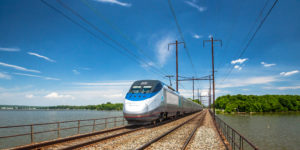WASHINGTON – As Amtrak launches a new era of rail [1], advancing infrastructure improvements on the Northeast Corridor (NEC) remains a key priority. This summer, annual track improvement work continues as part of a long-term effort to ensure the railroad operates at a level of peak performance. While this work may result in occasional temporary inconveniences, the long-term customer benefits are many, including increased reliability and improved on time performance.
“Updating railroad infrastructure is a fundamental component of our plan to deliver a new era of rail by modernizing the Amtrak fleet, building new bridges and tunnels, revitalizing stations and redefining the customer experience for the modern era,” said Amtrak Executive Vice President, Capital Delivery Laura Mason. “We’re grateful to our partners for their cooperation and flexibility as we advance these critical projects to achieve a state of good repair and enhance the overall Amtrak customer experience.”
It’s important to note that Amtrak customers traveling on the Northeast Corridor through September 30 may experience minor delays in various locations throughout the New England and Mid-Atlantic Regions this summer as a result of this track work.
Amtrak has committed approximately $130 million for rail improvements, of which over $124 million will be invested this summer.
This investment is made possible by:
- Amtrak grants and other federal programs
- State and local contributions
- Amtrak revenue
Specifics of the work include:
- Replacing 40 track switches throughout New York and Mid-Atlantic regions
- Updating 25 miles of track in the Mid-Atlantic Region
- Completing over one million feet of surfacing work across the entire NEC for high-speed rail
Newly adjusted train schedules account for this work and avoid conflicts with commuter agencies; however, customers may experience minor delays. For each project, Amtrak crews are working overnight to further minimize impacts to customers.
In addition, customers should be aware that high temperatures in the upcoming warmer summer months can also impact Amtrak operations. Extreme heat can cause rail, bridge and overhead wires to expand. As a safety measure, Amtrak enacts temporary heat restrictions [2] as needed. These restrictions require locomotive engineers to operate trains at lower speeds than under normal operating conditions.[/vc_column_text][/vc_column][/vc_row][vc_row type=”in_container” full_screen_row_position=”middle” column_margin=”default” column_direction=”default” column_direction_tablet=”default” column_direction_phone=”default” scene_position=”center” text_color=”dark” text_align=”left” row_border_radius=”none” row_border_radius_applies=”bg” overflow=”visible” overlay_strength=”0.3″ gradient_direction=”left_to_right” shape_divider_position=”bottom” bg_image_animation=”none”][vc_column column_padding=”no-extra-padding” column_padding_tablet=”inherit” column_padding_phone=”inherit” column_padding_position=”all” column_element_direction_desktop=”default” column_element_spacing=”default” desktop_text_alignment=”default” tablet_text_alignment=”default” phone_text_alignment=”default” background_color_opacity=”1″ background_hover_color_opacity=”1″ column_backdrop_filter=”none” column_shadow=”none” column_border_radius=”none” column_link_target=”_self” column_position=”default” gradient_direction=”left_to_right” overlay_strength=”0.3″ width=”1/1″ tablet_width_inherit=”default” animation_type=”default” bg_image_animation=”none” border_type=”simple” column_border_width=”none” column_border_style=”solid”][image_with_animation image_url=”9102″ image_size=”full” animation_type=”entrance” animation=”None” animation_movement_type=”transform_y” hover_animation=”none” alignment=”” border_radius=”none” box_shadow=”none” image_loading=”default” max_width=”100%” max_width_mobile=”default”][/vc_column][/vc_row]
